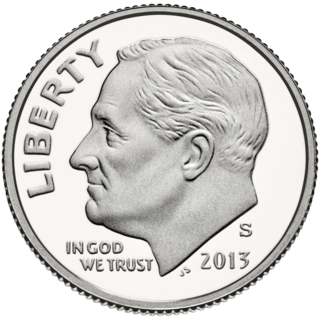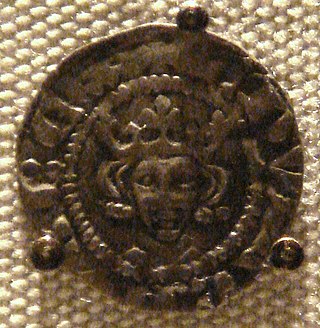
The standard circulating coinage of the United Kingdom, British Crown Dependencies and British Overseas Territories is denominated in pennies and pounds sterling, and ranges in value from one penny sterling to two pounds. Since decimalisation, on 15 February 1971, the pound has been divided into 100 (new) pence. Before decimalisation, twelve pence made a shilling, and twenty shillings made a pound.

The penny of Great Britain and the United Kingdom from 1714 to 1901, the period in which the House of Hanover reigned, saw the transformation of the penny from a little-used small silver coin to the bronze piece recognisable to modern-day Britons. All bear the portrait of the monarch on the obverse; copper and bronze pennies have a depiction of Britannia, the female personification of Britain, on the reverse.

The British florin, or two-shilling piece, was a coin worth 1⁄10 of one pound, or 24 pence. It was issued from 1849 until 1967, with a final issue for collectors dated 1970. It was the last coin circulating immediately prior to decimalisation to be demonetised, in 1993, having for a quarter of a century circulated alongside the ten-pence piece, identical in specifications and value.

The British farthing abbreviated qua., was a denomination of sterling coinage worth 1/960 of one pound, 1/48 of one shilling, or 1/4 of one penny; initially minted in copper and then in bronze, which replaced the earlier English farthings. Before Decimal Day in 1971, Britain used the Carolingian monetary system, wherein the largest unit was a pound sterling of 20 shillings, each of 12 pence. Each penny was divided into 4 farthings, thus, a pound sterling contained 960 farthings, and a shilling contained 48 farthings. From 1860 to 1971, the purchasing power of a farthing ranged between 12p and 0.2p in 2017 values.

The British threepence piece, usually simply known as a threepence, thruppence, or thruppenny bit, was a denomination of sterling coinage worth 1⁄80 of one pound or 1⁄4 of one shilling. It was used in the United Kingdom, and earlier in Great Britain and England. Similar denominations were later used throughout the British Empire and Commonwealth countries, notably in Australia, New Zealand and South Africa.

The dime, in United States usage, is a ten-cent coin, one tenth of a United States dollar, labeled formally as "one dime". The denomination was first authorized by the Coinage Act of 1792.
The British farthing was a British coin worth a quarter of an old penny. It ceased to be struck after 1956 and was demonetised from 1 January 1961.

The British sixpence piece, sometimes known as a tanner or sixpenny bit, was a denomination of sterling coinage worth 1⁄40 of one pound or half of one shilling. It was first minted in 1551, during the reign of Edward VI, and circulated until 1980. The coin was made from silver from its introduction in 1551 until 1947, and thereafter in cupronickel.
The coins of Canada are produced by the Royal Canadian Mint and denominated in Canadian dollars ($) and the subunit of dollars, cents (¢). An effigy of the reigning monarch always appears on the obverse of all coins. There are standard images which appear on the reverse, but there are also commemorative and numismatic issues with different images on the reverse.

The British halfpenny coin was worth 1/480th of a pound sterling. At first in its 700-year history it was made from silver, but as the value of silver increased the coin was made from base metals. It was finally abandoned in 1969 as part of the process of decimalising the British currency. "Halfpenny", colloquially written ha'penny, was pronounced HAY-pə-nee; "1 ½d" was spoken as a penny ha'penny or three ha'pence.
The threepence or threepenny bit was a denomination of currency used by various jurisdictions in England, Ireland, Scotland and Wales, valued at 1/80 of a pound or 1⁄4 of a shilling until decimalisation of the pound sterling and Irish pound in 1971. It was also used in some parts of the British Empire, notably Australia, New Zealand and South Africa.
The One guilder coin was a coin struck in the Kingdom of the Netherlands between 1818 and 2001. It remained in circulation until 2002 when the guilder currency was replaced by the euro. No guilder coins were minted in the German occupation of the Netherlands in World War II.

This article provides an outline of the currency of Spanish America from Spanish colonization in the 15th century until Spanish American independencies in the 19th. This great realm was divided into the Viceroyalty of New Spain, which came to include all Spanish territory north of Panama, the West Indies, Venezuela, and the Philippines, and the Viceroyalty of Peru, which included Panama and all Spanish territory in South America except Venezuela. The monetary system of Spanish America, originally identical to that of Spain, soon diverged and took on a distinctive character of its own, which it passed on to the independent nations that followed after.

The British shilling, abbreviated "1s" or "1/-", was a unit of currency and a denomination of sterling coinage worth 1⁄20 of one pound, or twelve pence. It was first minted in the reign of Henry VII as the testoon, and became known as the shilling, from the Old English scilling, sometime in the mid-16th century. It circulated until 1990. The word bob was sometimes used for a monetary value of several shillings, e.g. "ten-bob note". Following decimalisation on 15 February 1971 the coin had a value of five new pence, and a new coin of the same value but labelled as "five new pence" or "five pence" was minted with the same size as the shilling until 1990, after which the shilling no longer remained legal tender. It was made from silver from its introduction in or around 1503 until 1946, and thereafter in cupronickel.
The Romanian one-ban coin is a unit of currency equalling one one-hundredth of a Romanian leu. It is the lowest-denomination coin of the present currency and has been minted every year since the leu was redenominated in 2005. As well as Romania, the coin has been minted in the United Kingdom (1867), Germany (1900) and Russia (1952).
The five bani coin is a coin of the Romanian leu. It is the second-lowest denomination of the present circulating coins, introduced to circulation on 1 July 2005.
The ten-bani coin is a coin of the Romanian leu. It was reintroduced on 1 July 2005 and is the second-largest denomination coin in Romania. In addition to Romania, it has been minted in the United Kingdom (1867), Belgium, Germany (1906) and Russia (1952).
The fifty-bani coin is a coin of the Romanian leu. The fifty-bani is also the only coin of Romania to not be steel-based, but be made completely of an alloy, and was also the first coin in the country to have a written inscription on its edge, with the introduction of 4 new coins in 2019.
The one leu coin was a coin of the Romanian leu. Introduced in 1870, it last circulated between 1992 and de facto 1996, when it was the lowest-denomination coin in the country. It was considered as circulating coin for accounting reasons and was still minted in proof sets until the 2005 denomination of the currency.

The English farthing was a coin of the Kingdom of England worth 1⁄4 of a penny, 1⁄960 of a pound sterling. Until the 13th century, farthings were pieces of pennies that had been cut into quarters to make change. The first English farthing coins were minted in the 13th century, and continued to be struck until the early 18th century, when England merged into the Kingdom of Great Britain in 1707.











